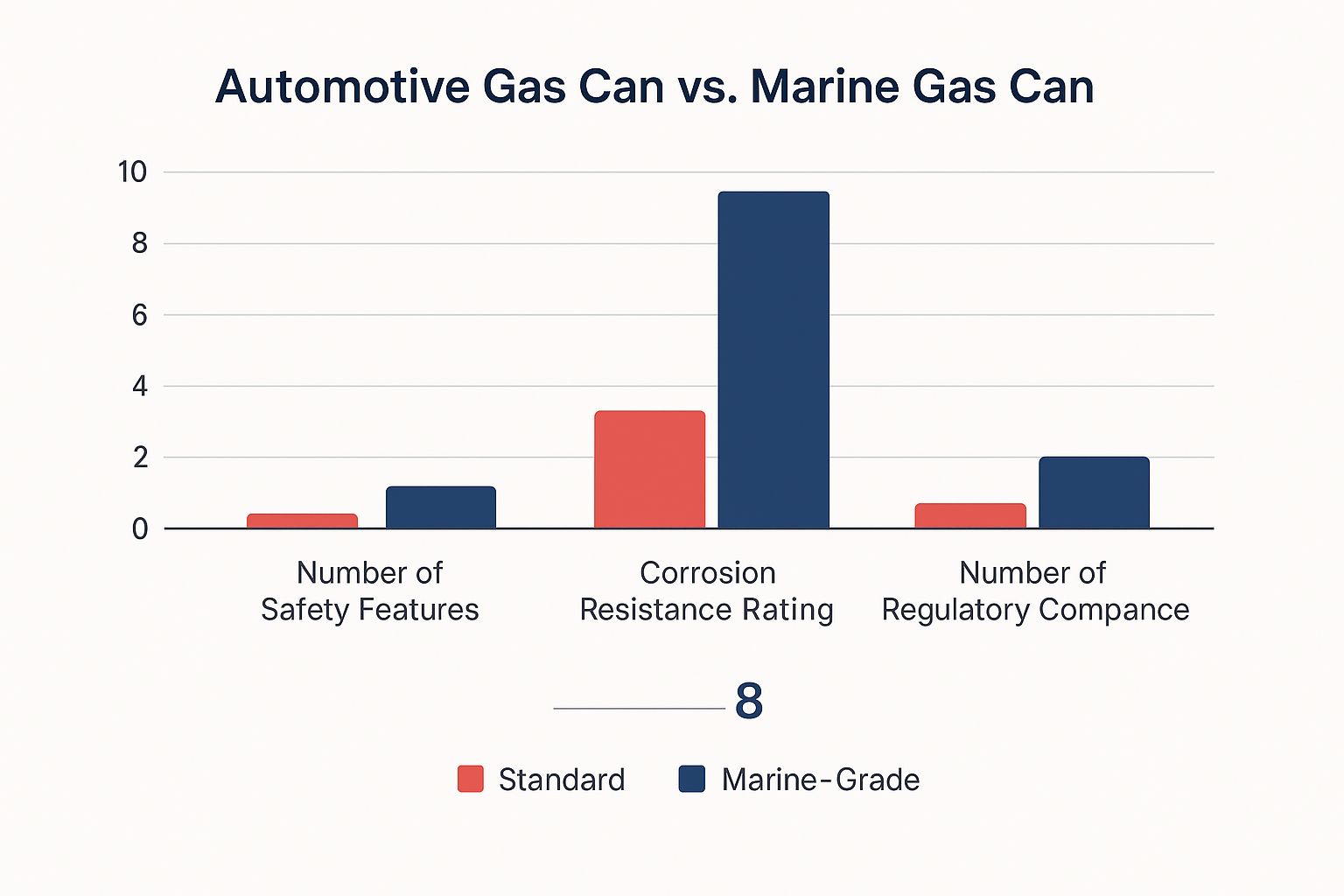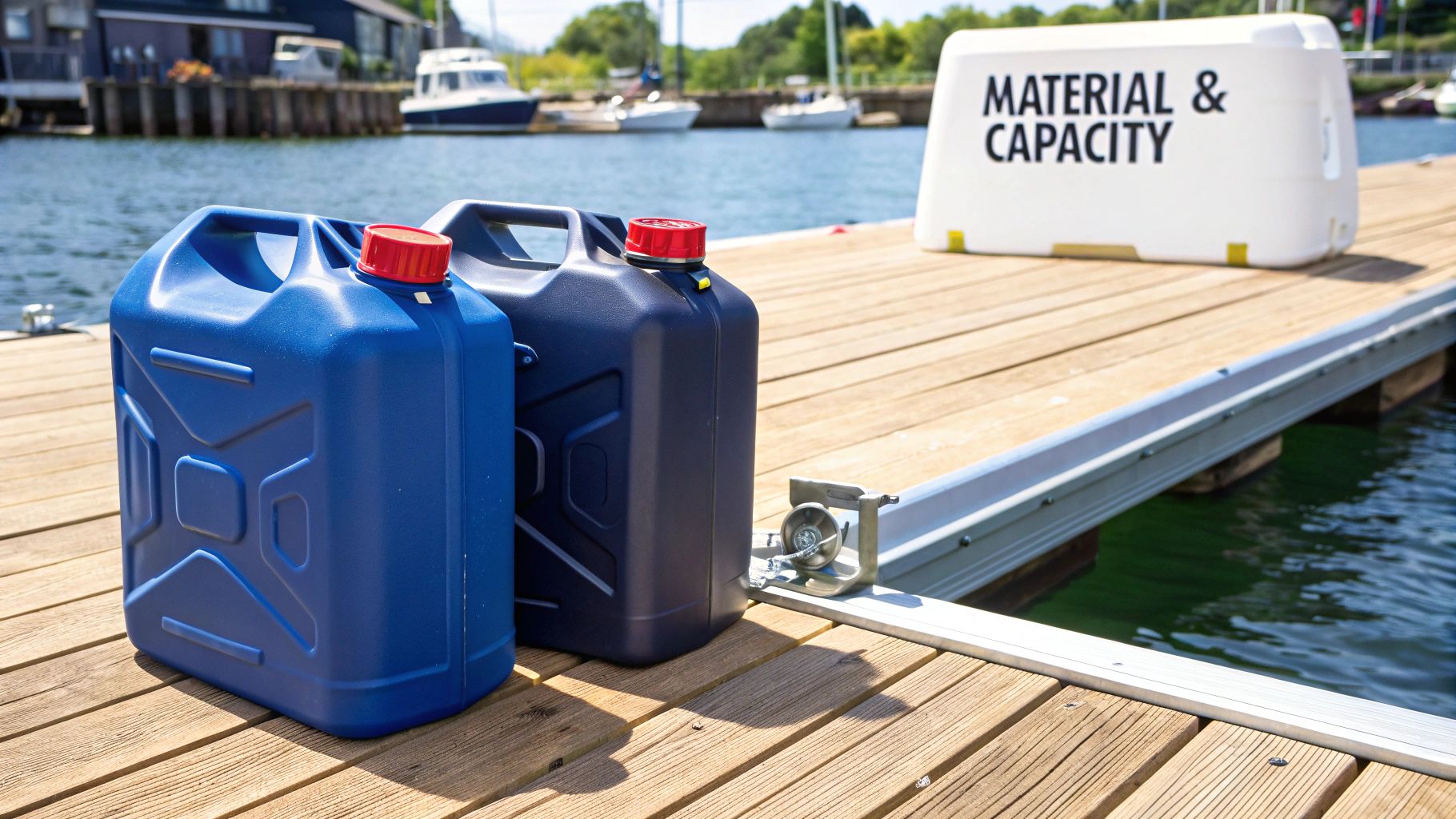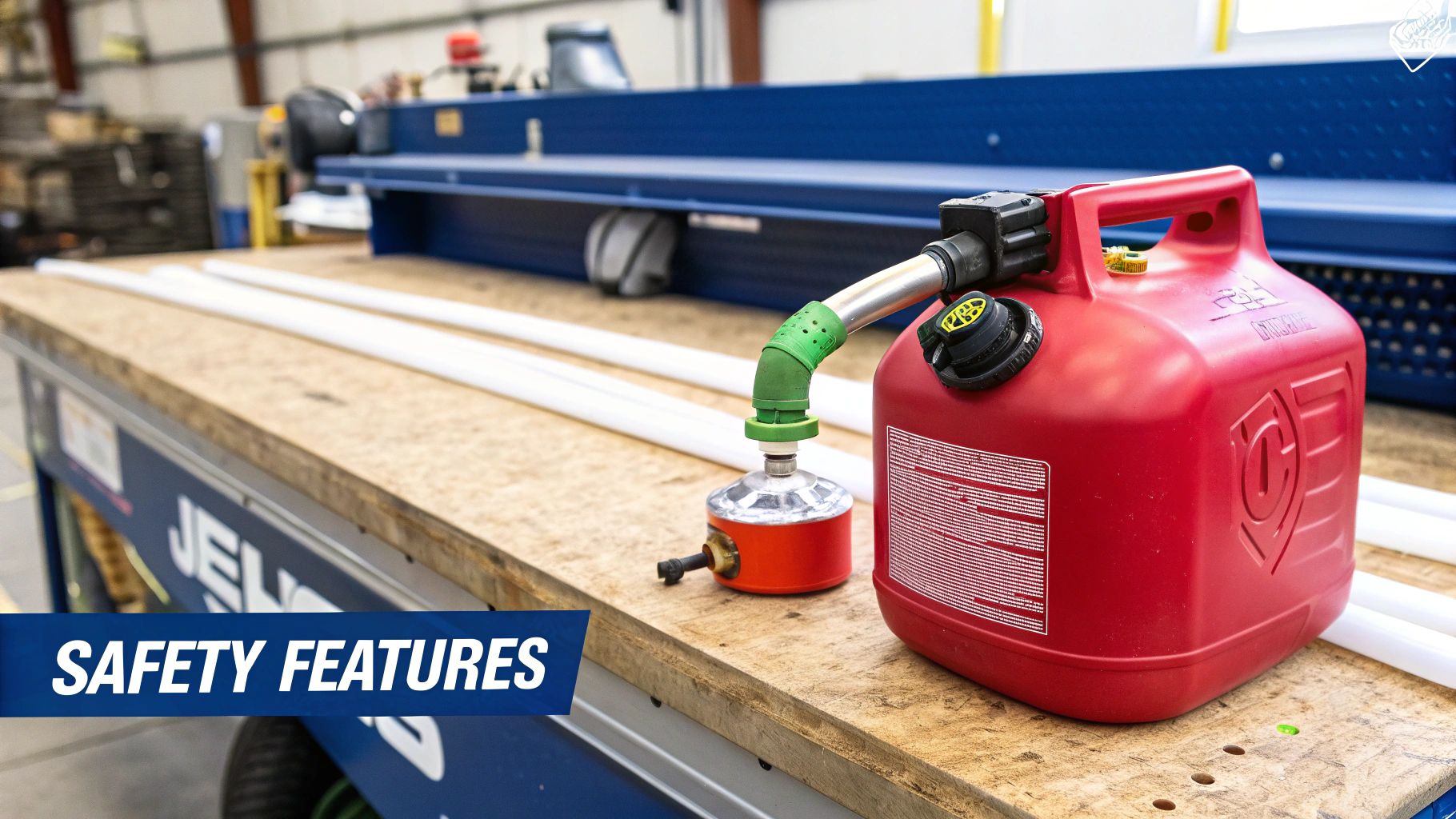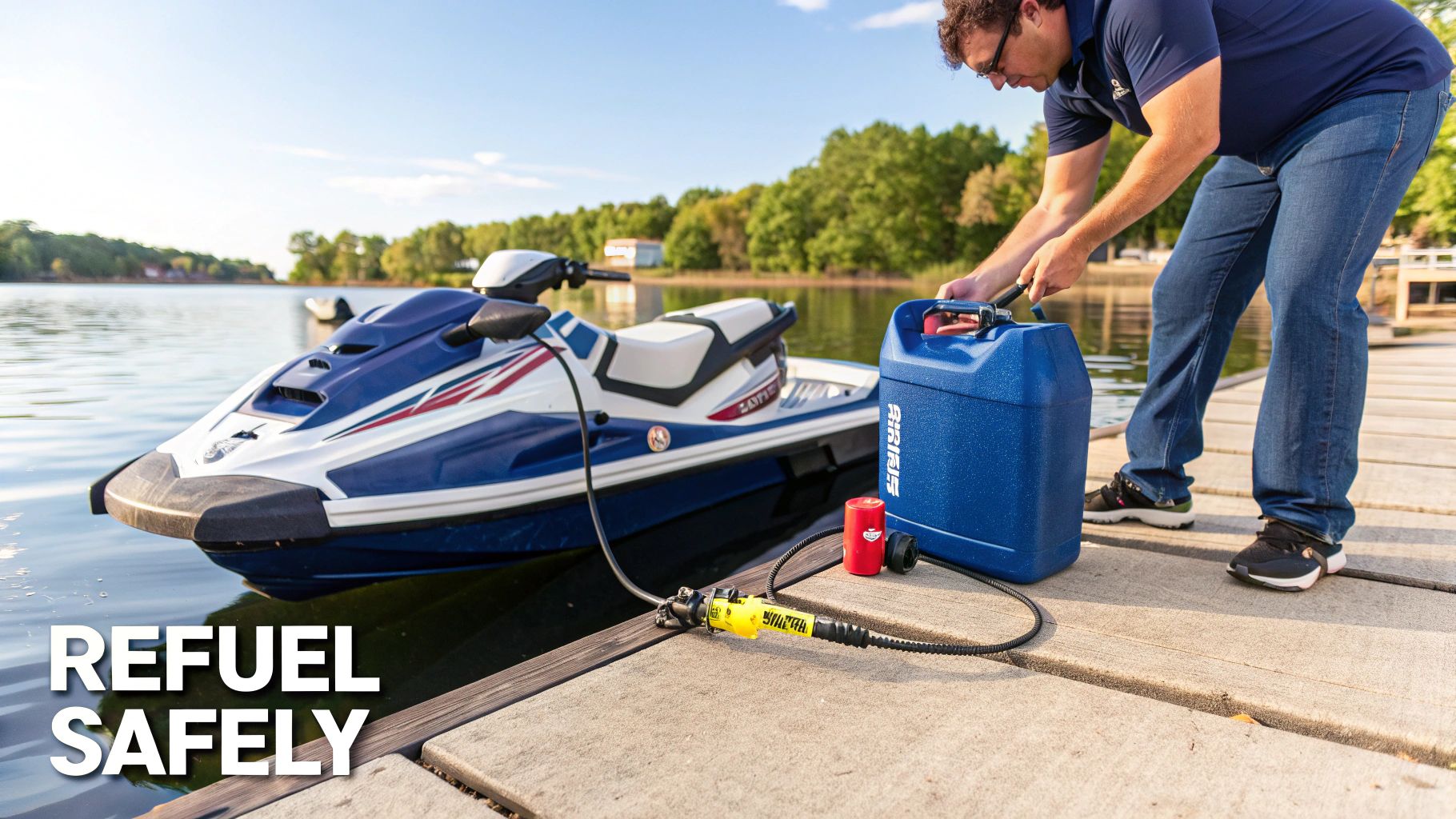It's a common mistake, but grabbing that standard red gas can from your garage for your jet ski is a seriously bad idea. Using one isn't just risky; it can lead to dangerous spills and even damage your personal watercraft (PWC).
Specialized jet ski gas cans are a different breed entirely. They're built tough to handle the unique abuse of a marine environment, with better materials and safety features that your average can just doesn't have. It really boils down to using the right tool for the job.
Why Your PWC Needs a Specialized Gas Can
Think about it this way: would you use a kitchen knife to chop down a tree? Of course not. It's not only the wrong tool, but it's also incredibly unsafe. That’s the best way to think about using a standard automotive gas can for your jet ski—it’s a total mismatch for the environment it's about to enter.
Your PWC is constantly dealing with saltwater, intense sun, and non-stop vibration. The cheap plastic cans you find at the gas station just aren't designed to withstand that kind of punishment.
The Marine-Grade Difference
So, what makes a marine-grade fuel can so special? It all comes down to materials and features designed specifically for the water. Here’s where they really stand apart:
- Corrosion Resistance: Saltwater eats through things. Marine cans are typically made from high-density polyethylene (HDPE) or specially coated metals that won’t rust or break down.
- Enhanced Safety Systems: Fueling up on the water has its own set of dangers. That’s why these cans often have flame arrestors to prevent sparks from igniting fuel vapor, plus self-venting spouts to handle pressure changes from the heat.
- Regulatory Compliance: Many are built to meet strict EPA (Environmental Protection Agency) and CARB (California Air Resources Board) standards designed to prevent spills and reduce harmful vapor emissions.
It's a bigger deal than you might think. With the personal watercraft market expected to hit around $2.21 billion by 2032, more people than ever are hitting the water. This growth means the need for safe, reliable gear like proper jet ski gas cans is only going to increase. You can dig into more of the PWC market trends and its growth if you're curious.
This chart lays out the critical differences between a standard automotive can and a purpose-built marine fuel can pretty clearly.

When you look at it this way, it’s obvious that marine-grade cans are far superior in safety, durability, and compliance. Honestly, they’re the only smart choice for your PWC.
Choosing The Right Material and Capacity

When it comes to picking the perfect gas can for your jet ski, it really boils down to two things: what it’s made of and how much gas it holds. Getting this right is about more than just convenience; it’s a crucial part of staying safe and worry-free out on the water.
The material of your gas can is its most important feature. You’ll mostly find two kinds on the market: high-density polyethylene (HDPE) plastic and classic metal. Each one has its own set of pros and cons, especially when you factor in the tough marine environment.
Plastic vs. Metal: The Great Debate
There's a good reason why HDPE plastic cans are what you see most riders using. They’re lightweight, they won't rust (a huge plus around saltwater), and they can take a beating without denting. For the kind of bouncing around and splashing that happens on a PWC, they’re practically made for the job. Plus, they’re usually easier on the wallet.
On the other hand, you have metal cans, usually steel or aluminum. These things are incredibly tough and offer the best protection against punctures. If you’re a rider who values pure ruggedness over everything else, a metal can is a solid bet. Just make sure it has a good marine-grade coating to fight off the inevitable corrosion from saltwater spray.
Rider Insight: We've seen a huge shift in recent years. It turns out that around 70% of jet ski owners are now opting for cans made from modern materials like HDPE, especially those with updated safety features. It shows a real trend toward prioritizing both safety and being more environmentally conscious.
For the vast majority of PWC riders, the combination of low weight, rust-proof durability, and affordability makes HDPE the clear winner.
Jet Ski Gas Can Material Comparison
To make the choice easier, let's break down the key differences between the two main materials you'll be looking at. This table gives you a quick, at-a-glance comparison to see which one fits your riding style and needs best.
| Feature | High-Density Polyethylene (HDPE) | Metal (Steel/Aluminum) |
|---|---|---|
| Durability | Highly resistant to dents and impacts. | Excellent puncture resistance, but can dent. |
| Corrosion Resistance | 100% rust-proof, making it perfect for saltwater. | Requires a protective coating to prevent rust/corrosion. |
| Weight | Lightweight and easy to handle, even when full. | Heavier, which can be a factor when securing it on a PWC. |
| Cost | Generally more affordable. | Typically more expensive upfront. |
| Best For | Most recreational riders who need a reliable, low-maintenance option. | Riders in extreme conditions who prioritize puncture-proof ruggedness. |
Ultimately, both materials can get the job done, but HDPE plastic's natural resistance to the marine environment gives it a significant edge for everyday jet ski use.
Finding Your Perfect Fuel Capacity
Okay, so you've thought about the material. Now, how much extra fuel should you actually bring? It's a balancing act. Too little, and you risk getting stranded. Too much, and you're just hauling around extra weight that can mess with your jet ski's agility and performance.
For most people out for a fun day on the water, a 5-gallon container is the sweet spot. It gives you a serious boost in range without being a massive, awkward container to lug around and strap down. If you're looking for recommendations, our guide on the best 5-gallon gas container is a great place to start.
To figure out exactly what you need, think about these three things:
- Your Jet Ski's Thirst: A big, supercharged engine is going to guzzle fuel way faster than a smaller, non-supercharged one. Dig out your owner's manual and look up its fuel consumption, usually listed in gallons per hour (GPH).
- Your Average Day Out: Are you just zipping around for a couple of hours, or are you planning an all-day expedition to that remote island? The length of your typical trip is the biggest factor in how much reserve you’ll need.
- Access to Fuel Docks: Think about where you ride. If there are marinas every few miles, you can get by with less. But if you're heading deep into a lake or down a long stretch of coastline, you are your only refueling station.
By considering these points, you can pick a gas can capacity that gives you total peace of mind without turning your nimble PWC into a sluggish tanker.
Decoding Essential Safety Features

When you're dealing with gasoline—especially on a hot, vibrating jet ski out on the water—"good enough" just doesn't cut it. Modern jet ski gas cans are built with layers of protection that work in tandem to prevent disaster. These aren't just fancy add-ons; they're essential systems designed to keep you, your PWC, and the environment safe.
Getting a handle on how these features work is the key to understanding why a purpose-built marine can is an absolute must-have. Each component is there to tackle a specific risk that comes with refueling in a less-than-stable, open-water setting.
The Flame Arrestor: Your Invisible Firefighter
Think of a flame arrestor as a tiny firefighter built right into the spout of your gas can. It's essentially a small metal screen with a super-fine mesh grid. It lets fuel vapor and air pass through easily enough, but that mesh is a game-changer. It absorbs and dissipates heat so well that an external spark or flame simply can't travel back into the can and ignite the dangerous fumes inside.
It’s a beautifully simple concept with a massive impact. This one little feature is what stops a minor mishap, like a stray static spark, from becoming a full-blown explosion.
Self-Venting Spouts: Preventing Pressure Buildup
A gas can left out in the sun is a bit like a shaken-up soda bottle—pressure is building up fast. As gasoline gets warm, it expands and creates vapor. Without a safe way for that pressure to escape, the can could swell up, warp, or even burst open, creating a seriously hazardous fuel leak.
This is where a self-venting spout comes in. It acts like a one-way pressure relief valve, automatically letting excess vapor escape as it builds. Not only does this stop the can from bloating dangerously, but it also gives you a smooth, glug-free pour when it's time to refuel.
A vent that works correctly is critical for both safety and usability. It keeps the pressure inside the can neutral, which prevents dangerous swelling and ensures the fuel flows out steadily and predictably. That means fewer messy, hazardous spills.
Automatic Shut-Off Nozzles: The Spill Stopper
Finally, the automatic shut-off nozzle is your last line of defense against messy overfills and spills. It works a lot like the pump at a gas station. These spouts are designed to automatically stop the flow of fuel the second the tank is full. This is a lifesaver when you're refueling on the water, where rocking waves can make it nearly impossible to judge the fuel level by eye.
These features all work together to create a safe, reliable fueling system:
- The flame arrestor is there to prevent ignition.
- The self-venting spout is there to manage pressure.
- The shut-off nozzle is there to prevent spills.
Together, they turn what could be a dangerous chore into a safe, routine part of your day on the water. They make sure every last drop of fuel gets into your tank and nowhere else.
How to Refuel Your Jet Ski Safely on the Water

Topping off your jet ski’s tank on the water can feel a little nerve-wracking at first. But with a bit of practice and the right approach, it becomes second nature. It’s all about turning a potentially tricky situation into a controlled, safe routine with a bit of prep and a steady hand.
Before you even touch a gas can, the first step is finding the right spot. Think of it like pulling over on the side of the road—you need a safe place away from any action. Look for a calm cove or a quiet, sheltered area where you won't be rocked by waves from other boaters.
Safety First: Never refuel while the engine is running or hot. Always kill the engine and let it sit for a few minutes to cool down before you even think about opening the fuel cap. This is the single most important step to prevent gasoline vapors from igniting on a hot engine part.
Once you’ve found your calm spot and shut everything down, you're ready to get started. Having your gear handy at this point makes all the difference.
The Pre-Fueling Checklist
Running through a quick mental checklist before you start pouring can save you a lot of grief. A smooth refueling is a safe one, and that starts before a single cap is unscrewed.
- Engine Off: Is the engine completely off? Key out of the ignition? Double-check.
- Passengers Away: Make sure anyone else on board knows what's happening and is seated. The last thing you need is a sudden movement rocking the ski.
- Spill Equipment Ready: Keep an absorbent pad or an old rag right next to you. Wrapping it around the fuel opening can catch any drips before they hit the water.
- Extinguisher Accessible: Know exactly where your fire extinguisher is and make sure you can grab it in a split second.
This little ritual takes less than a minute but sets you up for a spill-free fuel transfer.
Pouring Fuel Like a Pro
Alright, time for the main event. Your technique here is what separates a clean fill-up from a messy, potentially dangerous spill. This isn't about speed; it's about being steady and controlled.
- Position Yourself Correctly: Find a stable position on the jet ski, whether you're kneeling or sitting, where you can easily reach the fuel tank and the gas can without stretching or losing your balance.
- Vent the Can: Before you tip it, crack the vent on your gas can or slightly loosen the cap. This lets any built-up pressure escape and prevents that dreaded "glug-glug" surge that splashes fuel everywhere.
- Use Two Hands: Get the spout firmly into the fuel fill. Use one hand to keep the spout in place and the other to support the weight of the can.
- Pour Slowly and Steadily: Tip the can and pour at a slow, consistent rate. Don't rush it. You can often hear the pitch change as the tank gets full.
- Don’t Overfill: This is a big one. Stop when the tank is about 90% full. Fuel expands in the heat, and that extra space prevents it from overflowing out of the vent. We cover this in more detail in our guide on how to handle a boat fuel fill the right way.
- Secure Everything: Screw the fuel cap back on your PWC—tight. Do the same for your gas can. Wipe up any little drips with your rag and stow it in a bag to dispose of properly back on shore.
Follow these steps every time, and you’ll be refueling with confidence, keeping your day on the water safe and fun.
Storing and Maintaining Your Fuel Cans
A good jet ski gas can will last you for years, but only if you take care of it. Think of it less as just a container and more as a crucial piece of safety equipment. Proper storage and a little routine maintenance go a long way in keeping it reliable and, most importantly, safe.
Let's talk about storage first. You're dealing with gasoline, which is highly flammable, so where you keep your cans is a big deal. The golden rule is to find a spot that’s cool, dry, and has plenty of ventilation. A detached garage or a well-aired shed is perfect—somewhere separate from your main living area.
Whatever you do, never store fuel cans inside your house. Even the best cans can release vapors, and you don't want those building up where you live. Keep them far away from anything that could create a spark, like a furnace, water heater, or power tools.
Your Simple Maintenance Checklist
Before you even think about heading to the lake, get into the habit of giving your fuel can a quick once-over. This literally takes 30 seconds and can save you from a world of trouble.
- Check for Cracks and Bulging: Give the can a good look from all angles. You're searching for any hairline cracks, weak spots, or discoloration. If it looks swollen or bloated like a balloon, that's a major red flag for pressure buildup.
- Inspect the Seals and Gaskets: That little rubber gasket inside the cap is your first line of defense against leaks. Make sure it’s soft and flexible, not brittle or cracked. A bad gasket means a bad seal.
- Test the Spout Mechanism: If your can has a modern safety spout, just give it a quick press to make sure the spring mechanism works smoothly and isn't gunked up with old fuel or dirt.
Found an issue? Don't even think about a DIY fix with duct tape. A damaged fuel can is a retired fuel can. The risk just isn't worth it—grab a new one.
Storing the can is one thing, but you also have to think about the fuel inside it. Old gas is an engine's worst enemy. It can gum up your jet ski's fuel system and lead to some seriously expensive repair bills.
This is where a good fuel stabilizer becomes your best friend, especially if you're storing fuel for more than a month or during the off-season. A little bit added to the can keeps the gas from breaking down, ensuring your PWC starts right up when you're ready to ride again.
For a deeper dive into this topic, check out our guide on how to store gasoline safely.
Fuel Can Laws: Staying on the Right Side of the Water
When you're out on the water, handling fuel isn't just about being careful—it's about following the law. The rules for portable fuel containers can feel a bit tangled, but they all boil down to one critical goal: keeping our waterways clean and safe from dangerous spills and fumes. Getting a handle on these regulations helps you be a responsible rider and, just as importantly, helps you buy the right gear from the start.
You'll notice two key acronyms stamped on any compliant jet ski gas can: EPA and CARB. These aren't just for show. They're official certifications telling you the can has passed strict government tests designed to protect the environment.
- EPA (Environmental Protection Agency): This is the nationwide standard. An EPA-certified can is built to stop gas vapors from seeping through the plastic itself and must have a spout that prevents spills.
- CARB (California Air Resources Board): California set an even higher bar with its regulations, and many other states have followed suit. A CARB-compliant can has extra features designed to trap gasoline fumes that would otherwise vent into the air.
So, What Do These Letters Actually Mean for You?
Think of those certifications as your seal of approval for safety and quality. When a can has both EPA and CARB logos, you know it's been put through the wringer to ensure it's as environmentally friendly as possible. This is exactly why you don’t see those simple, old-school open vents on new gas cans anymore.
Instead, modern cans use smart, self-venting spouts that only open up when you press down to pour. This clever design stops those nasty, invisible vapors from constantly escaping, which is a surprisingly big contributor to air pollution. It also massively cuts down the risk of accidentally dumping raw fuel into the lake or ocean—a disaster for marine life. It’s shocking how much water even a tiny amount of gas can contaminate.
By simply choosing a compliant gas can, you're doing your part to keep the air cleaner and our water healthier. It’s a small choice that adds up to a huge impact on the very places we love to ride.
While the nitty-gritty rules might change a little from state to state, your best bet is to just buy a can that’s certified by both the EPA and CARB. That way, you know you’re good to go, no matter where your next adventure takes you. It’s an easy way to show you’re a rider who respects the water as much as the ride.
Got Questions About Jet Ski Gas Cans? We've Got Answers.
Alright, even after you've got the basics down, a few nagging questions always seem to surface. Let's tackle some of the most common ones we hear from riders, so you can head out on the water with confidence.
Can I Just Use a Regular Red Gas Can for My Jet Ski?
This is easily the number one question we get, and the answer is a hard no. It’s tempting to grab that standard can from your garage, but it’s a bad idea for a few critical reasons.
Your typical automotive can isn't built for the harsh marine environment. It lacks the special materials needed to resist saltwater corrosion and isn't designed to withstand the constant, jarring vibration of a PWC.
More importantly, a proper marine fuel can has safety features you simply won't find on a standard can. We're talking about things like a flame arrestor to prevent ignition and a truly spill-proof spout designed for the tricky task of refueling on the water. A car-and-lawnmower can just isn't worth the risk.
What's the Best Way to Strap a Gas Can to My PWC?
Whatever you do, don't just let it slide around back there. The absolute best way to secure extra fuel is with a dedicated PWC cargo rack. These are typically made from marine-grade aluminum and are designed to mount securely to the back of your ski, often using the built-in connection points so you don't have to drill any holes.
Once you have the rack, use a good set of UV-resistant straps to cinch the can down tight. You want zero wiggle room. This ensures it won’t shift, leak, or turn into a projectile if you hit some choppy water.
How Often Should I Replace a Plastic Jet Ski Gas Can?
Plastic degrades over time, especially when it’s constantly battling UV rays and harsh fuel vapors. Take a look at your can; you should find a manufacturing date stamped somewhere on it.
While there's no official, hard-and-fast expiration date, most safety experts will tell you to replace your plastic fuel cans every 5 years.
Beyond just age, give your can a quick once-over before every single ride. If you see any red flags—like cracks, fading, bulging, or the plastic feeling brittle—replace it immediately. A failing fuel can is a serious hazard you don't want to mess with.












